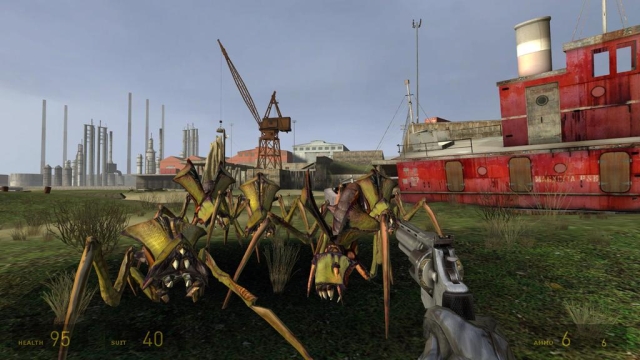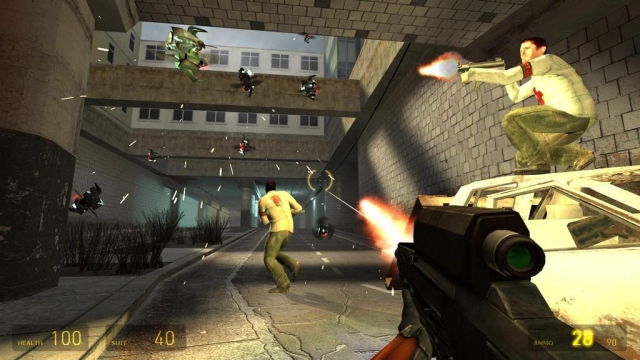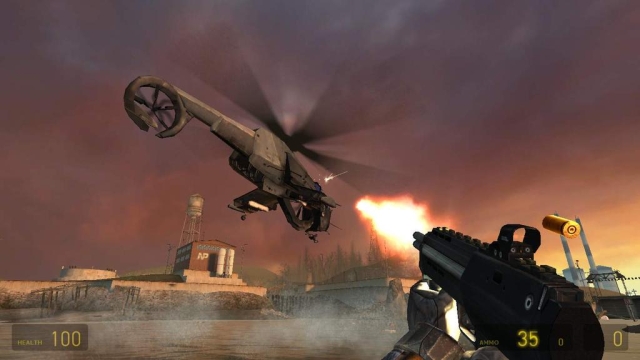Hall of Fame: Half-Life 2
 Welcome to the third instalment of the GodisaGeek Hall of Fame. Once a month we are taking a look at a game that the team feels is one of the greatest games of all time, and sharing our adoration for the title.
Welcome to the third instalment of the GodisaGeek Hall of Fame. Once a month we are taking a look at a game that the team feels is one of the greatest games of all time, and sharing our adoration for the title.
This month, it is the turn of Half-Life 2 to receive the Hall of Fame treatment. Half-Life 2 changed the FPS genre forever, and the team are here to tell you why it has the very special honour of being in the GodisaGeek Hall of Fame.
Martin Baker: Half-Life 2 was released in November 2004. I was 18 years old and I was there at the front of the queue as soon as HMV opened. I got the collector’s edition, I still have the T-Shirt that was inside, and I still remember the first time I got my hands on that tin box. The fact that I finally had the game I had been looking forward to, following every morsel of information I could get, for the last year at least was finally in my hands. At that moment in time I only cared about Half-Life 2, I never even began to think about what the repercussions of the newly created Source Engine would be for the video game world. All I cared about was that Half-Life 2 lived up to everything that it was supposed to be.
And it did.
From the moment the installation finished, booting up the game and looking around the train which was taking me to what I would come to know as City 17, I was hooked. I’d never seen a game world that felt so real, I couldn’t get enough. I still can’t. Every now and then I’ll go back and visit the world of Half-Life 2. All those characters, good and bad, that I’d come to recognise and respond to, the amazing story that’s still one of the best things in PC gaming, and the physics. Yes, they might not be the best physics in the world now but back then it was revolutionary, it was real.
Half-Life 2 is, was, and always will be one of the greatest games ever crafted. It took a while to get to us, and a lot of money too, but it was all worth it in the end, not only for the game itself but for the community it created, the Source Engine it’s based on and Steam, just to name a few. Things that gaming as we know right now wouldn’t have if it wasn’t for the little scientist and his crowbar.
Adam Cook: Where to even start with a game like Half-Life 2? Maybe with the first moment I realised it was something extraordinary. Years after the game initially came out on PC, as we all know, it was released as part of The Orange Box compilation, and even then, all those years later I still couldn’t decide whether to pick the can up and place it in the bin, or throw it at the horrible guard. Obviously, multiple playthroughs mean that I did both. There lies the genius of Half-Life 2 for me. With most story driven FPS titles, you’ll play through them, enjoy them and then move on. The universe Half-Life 2 takes place in, and the characters within (even the mute protagonist in Gordon Freeman) are so utterly engaging that despite knowing how the game is going to end, I have played through it multiple times.
Many developers have tried to convey such incredible character in their games since, but somehow, despite never saying anything, you feel part of the world. Alex is wonderful, and gives the game youthful exuberance, and the game has absolutely everything you could want in a FPS. Oh and of course, the crowbar. I still have screenshots that I took of messages I’d hammered into the wall over a soldier’s corpse, all via the crowbar. I knew even then that it was childish, but it was such a cool thing to be able to do.
I never get irritable at Episode 3 taking so long, because with games like Half-Life 2, Valve have cemented themselves in history as a developer that has earnt the right to take as long as they need, because let’s face it, we all know it’ll be amazing whenever they decide to release it.
Mary Goodden: Despite being an exceptionally good shooter with a strong arsenal of satisfying weapons, Half Life 2’s greatest achievement is its narrative. Playing it today, its self-assurance is so striking that it’s easy to forget that it was released at a time when rich stories and FPSs rarely entered the same building.
And yet the game’s generic conventions of a first-person perspective, lack of cutscenes and a silent protagonist are precisely what power the game’s storytelling. Gordon Freeman may be visually iconic (he’s a speccy nerd, not unlike many of the people controlling him), but the game allows the player to embody him completely. He never talks or reacts to other characters, so the player is never coerced into behaving in a certain way, meaning that the barriers to immersion that can plague action and adventure titles were removed. There can be no inconsistency in the behaviour of a character who never acts, and a player can feel no emotional distance from a character who never expresses an opinion. Freeman’s transparency does not weaken the narrative, instead, it allows the player to become him, and, in doing so, experience the world completely for themselves.
Of course, it helps that the world of City 17 is so beautifully realised. Although the Source engine was undeniably spectacular upon the game’s release, good design means that the game stil holds up well today. Clever use of colour and textures mean that the toxicity of the radioactive pools that spread across the city is visceral, and the various vehicles that Freeman must use to traverse the landscape feel appropriately flimsy and makeshift. The sparse environments make sense within a world oppressed by an Orwellian regime, and the lack of rich, saturated colour can be attributed to the desolation brought about by ubiquitous radioactive waste. Although much of the plot is conveyed by scripted events (though, crucially, never any which remove control from the player), much can be learned by exploring the dank, forgotten corners of the landscape. Desolate buildings contain traced of their former residents, workshops are littered with idiosyncratic nick-nacks, and the curious player can evesdrop on the conversations of various NPCs.
Since Half Life 2, game narratives have strived to become more “interactive”, and it seems that no title is complete without a variety of endings and alternative scenarios. Whilst this is to be both applauded and encouraged by all those who love the unique ways in which games tell stories, it does not always follow that the techniques these stories use are well-suited to the medium. Punctuating episodes of action with nuggets of story is all very well, but it does not make use of the unique ways in which games can convey a sense of place and history. Although Half Life 2’s story is completely linear (the player cannot influence its outcome in any way), its narrative methods are almost entirely interactive. Want to know about the relationship between Alyx Vance and Judith Mossman? Evesdrop on their arguments. Interested in the precise details of the Combine’s oppressive regime? Watch a televison broadcast by Earth Administrator Wallace Breen.
Half Life 2’s discipline and coherence makes it one of the most visceral and haunting narrative experiences that a gamer can have. The story never falters, and the emotional resonances are strong. By never forcing an action or opinion upon the player, the game allows them to make the experience their own, an astonishing feat given the linearity of both plot and level design. In terms of story, the game has rarely been bettered. The fact that the game also features a mini-nuke, the ability to summon a horde of deadly antlions and a gravity gun (best paired with buzz-saw discs) means that Half Life 2 is one of the best games ever made.
The GodisaGeek Hall of Fame will return next month!








